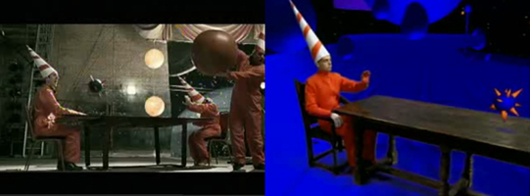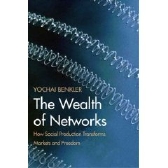What is a book? This is a question we will want to answer if we want to enable books to reflect the electronic age and not the ink-on-paper era, just as Gutenberg and his heirs fully exploited that once-new technology back when, well, the ink was still fresh.
I don’t think a precise definition is possible, certainly not one that will clearly and unambiguously delimit books, journals, magazines, newspapers, and any other print media, and also add electronicity without claiming blogs, RSS feeds, wikis, mail-lists, and website forums.[1] Each of these are distinct entities, yet might share every salient feature with most of the others at its margins.
I will instead go after What is our notion of a book? What is it I expect you to mean when you use that word instead of, say, “magazine” or “website”? [2]
So let us begin with this: “A book is something you read.” And by that we will not mean something we watch or view. [3]
While in a sense we have passed the buck to another philosophical discussion — What constitutes reading? — this allows us to now regard children’s books as entries into reading, and not annotated drawings. Moreover we have escaped making some arbitrary rules about the proportion of words to drawing or whether the artwork “illustrates” the text and such like.
Now saying a book is something you read means I regard a book of photographs as a book only in how I approach it psychologically based on its physical presentation. Remove the binding literally and figuratively and the book is no more — a slideshow of Ansel Adams photographs is no more a book [4] than it is a newspaper. The essence of book has expired along with the physical book.
And this starts us down a different path to answering our question of “What is a book?” If I can’t define a book the way I might define a hammer or an element in the periodic table or a songbird, I can at least identify characteristics or expectations that we all generally associate with a book. What results is less a definition in the dictionary sense than it is a diagnosis — any object meeting a majority of these symptoms will fall under our designation of “book,” even though other objects share some traits and not every trait is met by every instance.
So. What do we know about a book? Let us look at the general knowledge about books, the type that we use daily to distinguish books from other text media, as well as separating it from other media generally and from other artforms.
- A book presumes a commitment of time and involvement from the reader. No one expects to pore over a magazine for a month, to give twelve or fifteen or twenty hours involvement to Newsweek or Architectural Digest, but a worthy book can claim that time or more. In the implied contract between the reader and author, this is something we readers pay and based on which the author can set her sights much higher (or deeper) than with the alternatives.
- A book permits the reader to set his own pace. I don’t mean “you read slowly and I’m a fast reader” but that when reader and author fully engage we readers can slow down and reflect on what’s been said. We can savor the language, we can re-read the page, even copy the most expressive sentences in our commonplace books, all the while tussling with the words on the page, their meaning, their color, their elegance or abruptness or unexpected appearance, which operate in conjunction with but also separately from the meaning, from the ideas or events they convey.
“Reading maketh a full man … and writing an exact man,” Bacon said, and while the philosophers have mined the territory between what we intend when we put things into words and what we each understand those words to mean, the gap in communication is not complete. In reading and in writing we do find understanding in these glyphs on a page, and it comes entirely from our brains. And we might note how books cannot engage our several senses, except peripherally as we grasp a hefty book or screw up our nose at the cheap glue in a paperback’s binding. The vast capability of our visual acuity [5] is set aside and become a mere doorman to the intellect, which assumes the operative role in our reading, particularly what Bill Hill calls “ludic reading.” [6]
And we cannot hurry or slow down our understanding, but only delight in its delights and accompany its anguished plodding through tortuous texts. And so when I say a book lets us set our own pace — as a movie, symphony, dance or play cannot — I mean the pace at which our intellect maunders or gambols through the material set before it.
And every other part of us is diminished, as an audience sits quietly in the dark before a brightly lit actor on stage. Now is not the moment we notice the hard bottom of our chair or the light fading at day’s end or hunger or the voices of others conversing or calling to us; these are subordinate as our minds engage in work or recreation.
When people wonder whether a “book” might not in our future be so multidimensional, with sound, video, interactivity, and mutability to our desires, I say “yes, but.” Yes, these can be and should be and will be incorporated. But if “book” no longer means the intellect is permitted to come to the foreground in this way, if text and how it requires this is diminished to insignificance, then we will have thrown the baby out with the bathwater and what we have then will perhaps be entertaining and educational and absorbing, but it will not be a book, whatever label attaches to it.
- A book has an author’s voice, what Wayne Booth calls the implied author [7], with whom we converse or in whose academy we study or at whose feet we sit to hear the tales of the unfamiliar and entertaining. But we have an almost palpable relation with that author that is not so very different than we have with our friends.
This isn’t so easy with a movie, say, or a play, a TV show. We are more likely to engage on that level with the actors portraying the characters. In the message, the mood, the impression we take away, can we say confidently where the author leaves off and the director begins? We have an interaction but it is at a remove, it is less personal.
Will the same author’s voice be distinct in networked and collaborative books? Or will it be drowned out? Perhaps what we know of installation and performance art will guide us here — as art moved off the walls and away from the close and tangible, the artist did not disappear, did not transmogrify into an actor or impresario. The essence of art survived and with it the artist.
Like that famous dictum about obscenity from Potter Stewart, when he wrote that he might not be able to provide a test for it, “but I know it when I see it,” we must be guided by our intuition. Some aspects can change radically if the essence of the book is still recognizable. When we ask, What is a book? we know any answer will be slippery but our certainty is unwavering. In our test, it requires only that we remember the greater part of any book resides not in the physical, but in the invisible world. Then whether we have one author or a collaboration, unchanging text or mutable, physical pages or electronic, static images or dynamic, audio, video, connection to the web or not, whatever the manifestation the future brings us, there should be no confusion. Then as now, each of us will know a book when we see it.
[1] In part my conclusion of indefinability is based on similar effort undertaken years ago, when I was in graduate school. One professor set the students in his seminar to define what a poem was. As we attributed features to “a poem,” it was not hard to find counter examples — I remember a Thomas Wolfe sample brought in to counter the notion that rhythm distinguished poetry from prose. Language, purpose, length, rhythm, meter, rhyme, fixed patterns, brevity of expression — every feature could be countered with a prose sample that met the criteria and poems (which we all agreed were poems) that did not. Although we each had a notion of what constitutes a poem, we couldn’t create a definition that encompassed the essence of those notions.
What we settled on was the most rudimentary of differentiation, and yet unassailable — a poem is a text in which the author has decided where one line ends and the next begins.
[2] For instance, FTrain, a site written by Paul Ford in multiple voices, using multiple personae/bylines, mixing pieces that are not always obviously differentiable as being fiction, biography or memoir, as well as essay and reporting, and not incidentally relying on original musical compositions for full comprehension of the site.
[3] The audio book by this taxonomy is the platypus of content. Yes, it is a book. And yet we say mammals do not have bills and birds do, despite the contrary example of the platypus. Of course, the matter of illustrations, footnotes, maps, charts and such that we often utilize in a book do not fit so well in the audio book, so it is indeed an odd duck.
[4] It may come as a surprise that the contrary question of “Is a slideshow of The Castle a book?” is not that readily answered. It may well be. Assuming we are not seeing it formatted in Powerpoint bullets, the distinction between the pages of one of today’s e-books and a “slide” in that slideshow seems minuscule, one of projection onto a wall instead of display on a handheld device or computer. But the cohesiveness a binding provides those Ansel Adams photographs is more than matched in a novel by the linearity of the text, the consecutiveness of the sentences, the structure of a story being told. Without a binding, the photographs stand on their own, independent despite their sequence. Not so the text, where each page connects to its predecessor and successor. If we are to rule that a slideshow is not a book — not even a group-read book — it will have to be because it fails the criteria discussed later on.
[5] I repeat a famous observation noting how immediately in a crowded room we find someone’s eyes resting on us, and how small the actual visual information is, a fraction of a fraction of one percent of all that is visible to our eyes. Yet we scarcely recognize that we are the most visual of creatures.
[6 ] In his report that launched the Microsoft Reader, published as “The Magic of Reading.” [link to .lit version. To .doc version.]
[7] In his classic book, The Rhetoric of Fiction, another book I encountered first in graduate school.




 The Times yesterday ran a pretty decent article,
The Times yesterday ran a pretty decent article, 